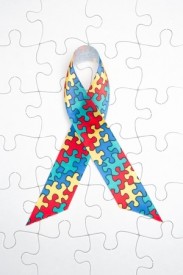 With approximately 1 in 68 children diagnosed with autism spectrum disorder (ASD) in the United States, millions of families are looking for research progress in this area. For Autism Awareness Month, we’ve compiled 4 of the latest research findings.
With approximately 1 in 68 children diagnosed with autism spectrum disorder (ASD) in the United States, millions of families are looking for research progress in this area. For Autism Awareness Month, we’ve compiled 4 of the latest research findings.
1. Autism is in the Genes
One of the most exciting recent developments in ASD research stems from large, genome-wide studies that have identified genes and genetic mutations that may contribute to ASD. Two such studies have uncovered 60 genes that have a greater than 90 percent chance of contributing to ASD among 500 or more genes associated with ASDs overall [Ronemus et al, (2014) Nature Reviews Genetics 15, 133-141]. More investigation is needed to dig deeper into the roles of these genes and how they affect the developing brain, but those data are emerging.
For example, a recent review of the genetic research published by Michael Ronemus and his colleagues has specified de novo mutations (that is, new mutations) in 12 genes that show strong causality of ASDs among boys. In another recent study, conducted by researchers at the University of California, Los Angeles, the authors reported on the impact of the gene CNTNAP2 on brain function. CNTNAP2 is associated with ASD and has been implicated in impaired language and thinking abilities. Scientists performed functional magnetic resonance imaging scans to compare brain function in carriers and noncarriers of the genetic risk factor. The study demonstrated that the nonrisk group had significantly lower activity in the medial prefrontal cortex during a task requiring processing of reward information. Additionally, there was increased and more diffuse functional brain connectivity in carriers of the genetic risk factor. Although higher connectivity may seem like a good thing, it may actually reflect an inefficient, immature profile of brain functioning. New research just published this month identified a gene that is very important to the development of neurons in utero, CCNND2, associated with ASD in girls found in families in which two or more females are diagnosed with ASDs. [Turner et al., (2015) Loss of δ-Catenin Function in Severe Autism. Nature 520, 51-54)].
2. Problematic Brain Pruning May Contribute to ASD
To understand exactly how these genetic mutations affect brain maturation, neuroscientists are also investigating what happens differently in the brains of children who have been diagnosed on the autism spectrum. From this perspective, researchers have begun investigating how the process of brain cell pruning may go awry in children with ASD. Pruning is the process by which a brain weeds out unimportant connections and strengthens the important ones, based on experience. In a recent report published in Neuron, the scientists reported that ASD may be associated with higher levels of a molecule that may impair the ability of brain cells to get rid of dysfunctional cell components.
3. White Matter Fiber Tracts Differ in Children with ASD
Another area of investigation of brain differences in children with ASDs has investigated white matter tracts, the superhighways of the brain that allow efficient information transfer between brain regions. Scientists at the University of North Carolina-Chapel Hill studied the development of white matter tracts in infants who later went on to be diagnosed with ASD. They found that at 6 months of age, infants with ASD had higher fractional anisotropy (FA) in key white matter tracts. FA is a measure of the directionality of white matter fibers, with higher FA signaling better microstructural organization. However, those infants with ASD had a slower change in FA over time, such that they had much lower microstructural organization by 2 years of age. This suggests that the trajectory of white matter development may be abnormal even a few months following birth in those who go on to receive an ASD diagnosis. In simple terms, the superhighways of the brain are not working as efficiently in children with ASD as they are for typically developing children.
4. Early Intervention Helps!
Scientists using the Early Start Denver Model (ESDM), a behavioral intervention, previously showed that this treatment significantly improved IQ and language abilities in toddlers with ASD. Researchers also investigated whether the intervention changes brain functioning. They used electroencephalography to assess electrical activity in the brain during a task involving looking at faces versus objects. Children who completed the ESDM intervention had faster neural response and higher cortical activation when looking at faces compared to objects. Those who received treatment as usual (a common community intervention) showed the opposite pattern. Additionally, higher cortical activation during face-viewing was associated with better social behavior. This suggests that the ESDM intervention may cultivate brain changes that result in higher IQ, language abilities and social behaviors.
Together, these exciting findings highlight the excellent work that is being done by scientists around the world to combat autism. From understanding the impact of individual molecules on brain cell structure to constructing more effective interventions, researchers continue to answer important questions about autism and give loved ones hope for the future of ASD care.
Further Reading:
Loss of mTOR-Dependent Macroautophagy Causes Autistic-like Synaptic Pruning Deficits
Dozens of Genes Associated with Autism in New Research
The role of de novo mutations in the genetics of autism spectrum disorders
Related Reading:
Understanding Autism in Children
Ben's Story: Intensive Intervention Helps a Young Boy on the Autism Spectrum Succeed


Comments
Hi! I would like to know if
Hello Kath, thanks for your
i have autism and i want to
Hi Vinnie, many scientists